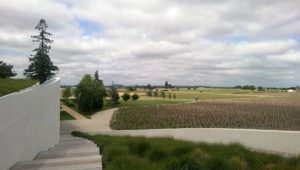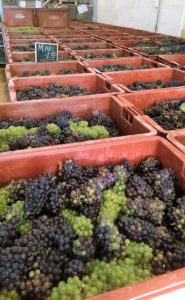
History of wine Museum in Bordeaux
Issues related to global warming are of great importance in the wine industry. In Europe, and France in particular, tens of thousands of hectares of vineyards may become unusable in the medium term, something which would have significant negative economic and social effects. So are we moving towards an unavoidable revolution in methods of growing, customs and even the very taste of wine itself? Grapevines have already experienced warming climates during the Roman Empire and Middle Ages, but the situation today is different. The global warming we are living through is anthropogenic (i.e. man- made) and is much quicker than previous such periods. There are fears in some areas that their grapevines will not be able to adjust to the new conditions. A number of large winemakers across the world are even preparing to move: Californian winemakers are moving to Oregon, Washington and British Columbia. Australia in the Southern Hemisphere is moving its vineyards south to Tasmania, while in Europe there has been a huge boom in vineyards in Great Britain, where there had been no winemakers for fifty years. There are currently four hundred vineyards in England and there are even attempts currently underway to plant vines in Scotland. Vineyards are growing up everywhere, even in places such as Poland.
The temperature in France has increased at a higher rate than the global average. There are real concerns that vineyards containing specific varieties used to a different climate and where the rootstocks are 30-60 years old may not be able to withstand the temperature shock. Climatologist Hervé Le Treut says that Aquitaine is one of France’s regions in which the warming may be strongest. In the champagne region of Reims, the average temperature increased between 1950 and 2006 twice as much as in the rest of France. In some Burgundy wine regions, the average minimum temperature in the 35 days before harvest increased by almost 4 °C between 1973 and 2005.

Vineyards at Chateau Cheval Blanc, Saint Emilion, France
Large winemakers are well aware of global warming, but small growers are less conscious of it, something of a trend because they sometimes confuse climate and weather and do not study bio-geophysical cycles in the way large growers do. They may well think that everything will get back to how it used to be and that nature will somehow sort itself out. One can still hear assertions such as: “The warmer, the better.” But that is only true to a certain extent. Currently, the climate is optimal in the Bordeaux region, and also in many regions of Italy. We can expect more frequent excellent vintages, but also smaller harvests since high temperatures go hand in hand with frequent very destructive storms and hail such as those which destroyed harvests this year and last year in many places. New varieties are now being tested out in Bordeaux and Champagne because these are amongst the regions most affected by global warming.
Global warming also results in sea-level rises as a result of icebergs melting, and also a rising water table, something which may have a serious impact on regions such as Médoc where vineyards are just a few metres above the sea and may become contaminated by brackish water. The presence of salt in the water prevents the vine from growing. The growth in average air temperature is also conducive to many types of pest, such as grapevine moths (Lobesia botrana) and cochylus, but even harmless insects may come to carry diseases such as flavescence dorée. Pests which thrive in tropical and dry areas are migrating north, often faster than had been expected. Some kinds of caterpillar have already moved north ten years earlier than had been anticipated.

Champagne, Villedomange, Chateau Bergeronneau, September 2016
Vines’ current poor resistance is partially a result of a lack of biological diversity. About 80% of French vineyards grow just fifteen varieties. There is much less diversity now than there was at the time of the Great French Wine Blight when dozens of local grape varieties were grown over small areas. In the event of disease, this is a great risk. Corsica serves as a model here, where growers are returning to original varieties already adapted to the soil. The vines here will probably have to be watered more, or the vines moved to higher elevations, but it appears that Corsica may be the region least affected by warming within the whole of the Mediterranean basin. Agricultural methods will likely also have to be changed, with growers intervening much less. Winemakers who persistently treat their vines, sometimes even just a few dozen metres from villages, are not behaving responsibly.
The question for the future, however, is not “What wine are we going to be drinking?” but rather: “What wine will we want to drink?” Rising temperatures increase the amount of sugar in the grape juice, thus also increasing alcohol content. This may impact on the balance between tannins, sugars, acidity and salt. If we can accept that wine will change, then hope remains, because new technologies can help us grow vines. Grape vines and wine have a bright future ahead of them, at least in the coming decades. The future of viticulture is not in doubt either, as long as we want and know how to adjust.
So the message for wine lovers is: “All is not lost”.
Author: Ing. Arch. Iva Drebitko
Photos: author’s archives
Sources: Valéry Laramée de Tanneberg, Yves Leers, Bernard Noblet, Aubert de Villaine

